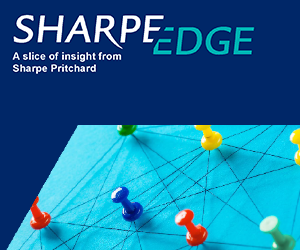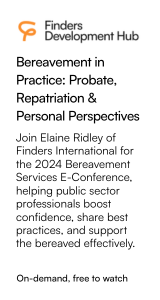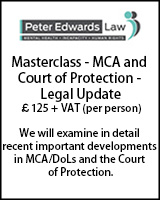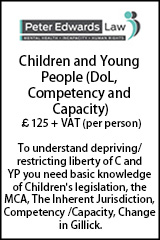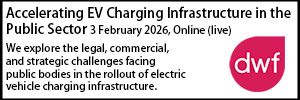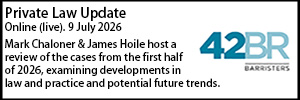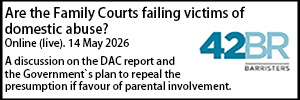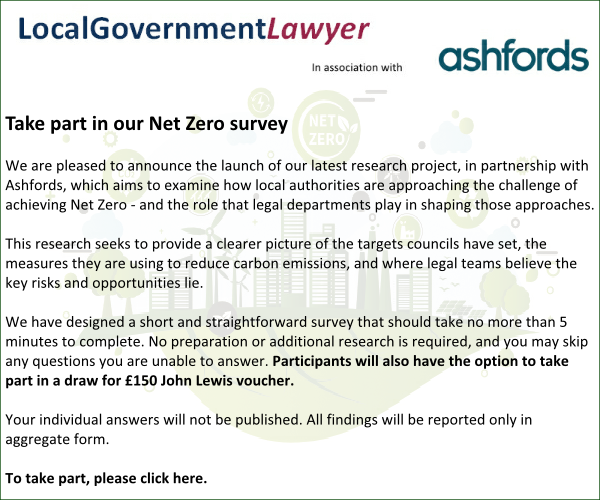Public law children case update: April 2025
- Details
Caitlin Smithey rounds up the latest public law children cases of interest to practitioners.
RE A and B – Declaration of Non-Parentage [2025] EWFC 41
Before Mr Justice Cobb in the Family Court
Factual background
This case concerned an application brought by the father, Mr J, for a declaration of non-parentage in respect of his two twin children aged 16 years old.
Mr J and the mother met in Cyprus in 2006 and in November 2007 underwent IVF treatment at a clinic in Cyprus. The eggs of the mother and an unknown donor’s sperm were used to achieve conception and the mother fell pregnant.
In April 2008, the parties married. A and B were born in the summer of that year. Mr J was listed as the father on their birth certificates.
By October 2009 the parties had separated and divorce proceedings took place in 2011. A clean break order was made in the Family Court in England in April 2012 in financial remedy proceedings and this expressly ordered that Mr J accepted financial responsibility for A and B. This order required him to pay £120 monthly in respect of each child.
Mr J has had no contact with the children of any kind since the mother and father separated fifteen years ago with ‘no visits, no cards, no letters, no photographs’. Throughout this period, he continued to maintain his financial commitment to the children. The mother accepts that these ‘payments have materially contributed to the children’s wellbeing’ as they were used to fund not only necessities but also school trips, clubs and holidays.
Mr J has brought this application as he has now retired from working due to ill-health and cannot continue to make these payments.
Legal principles
Section 55 of the Family Law Act 1986 is the relevant statutory provision for a declaration of non-parentage:
“(1) Subject to the following provisions of this section, any person may apply to the High Court, or the family court for a declaration as to whether or not a person named in the application is or was the parent of another person so named.
…
(5) Where an application under subsection (1) above is made and one of the persons named in it for the purposes of that subsection is a child, the court may refuse to hear the application if it considers that the determination of the application would not be in the best interests of the child.
(7) Where a declaration is made by a court on an application under subsection (1) above, the prescribed officer of the court shall notify the Registrar General, in such a manner and within such period as may be prescribed, of the making of that declaration”. (Emphasis by underlining added).
This is qualified by section 58:
(1) Where on an application to a court for a declaration under this Part the truth of the proposition to be declared is proved to the satisfaction of the court, the court shall make that declaration unless to do so would manifestly be contrary to public policy”.
Case law guidance has been provided on these provisions in the case of Re S (a child) (declaration of parentage) [2012] EWCA Civ 1160 where the following guidance was given by Black LJ:
“When determining an application of this kind, the Judge ‘is deciding whether a fact is established, in this case whether this man is the father of this child”; it is not “taking a discretionary welfare decision or making a value judgment”.
Re S also considered some theoretical cases in which the court would be likely to refuse to hear the application as it would be obvious to not be in the child’s best interests such as a teenager who is suicidal or a child is settled with adopters.
The Court also considered the case of P v Q and Others (Declaration Of Parentage) [2024] EWFC 85 which comments on the section 55 gateway as follows:
“[27] When considering best interests pursuant to section 55A(5), the court is not required to consider whether hearing the application is in the best interests of the named child but only to consider whether hearing the application would not be in the child’s best interests. Neither the paramountcy principle nor the welfare checklist in the Children Act 1989 are engaged in this exercise”
The father’s rights under Article 8 of the European Convention of Human Rights were also a consideration for the Court in this case. The authority used for this was MS v RS (Paternity) [2020] 2 FLR 689
“[95] … any decision by the court not to accede to the father’s request to legally determine whether he is the father of the children constitutes an interference with his right to respect for family life unless it is in accordance with the law, pursues an aim or aims that are legitimate and can be regarded as necessary in a democratic society. In addition, it would be unfair on the father, and arguably a further breach of his Art 8 rights, to remain indefinitely as the children’s legal father by virtue of a presumption if that is not the biological reality.
Section 55A of the FLA 1986 only applies in respect of applications made in respect of children. If Mr J were to wait until the children turn 18, this would not require passage through the jurisdiction gateway.
For this application to proceed through the jurisdiction gateway, the legal parentage of A and B would be considered with reference to the Human Fertilisation and Embryology Act 1990 which is the relevant statute that was in force at the time of their conception via IVF. Section 28 is the relevant provision stating:
“(1) Subject to subsections (5A) to (5I) below, this section applies in the case of a child who is being or has been carried by a woman as the result of the placing in her of an embryo or of sperm and eggs or her artificial insemination.
(2)…[relevant to married parties at the time of the conception… therefore not relevant here]
(3) If no man is treated, by virtue of subsection (2) above, as the father of the child but—
(a) the embryo or the sperm and eggs were placed in the woman, or she was artificially inseminated, in the course of treatment services provided for her and a man together by a person to whom a licence applies, and
(b) the creation of the embryo carried by her was not brought about with the sperm of that man, then, subject to subsection (5) below, that man shall be treated as the father of the child.”
The requirement of license referred to in Section 28(3)(a) has been confirmed in U v W (Attorney General Intervening) [1998] Fam 29; [1997] 2 FLR 282 to be a domestic article and does not apply to treatment which occurred overseas. For this section to have bearing therefore, the treatment services must be provided in the United Kingdom by a person to whom the licence applies.
The decision
Upon speaking with the children and gathering their view, the Guardian considered that the making of such an order would have minimal impact on the children’s psychological wellbeing as they are resilient children who have never had a relationship with Mr J. The key impact on the children would be financial.
The mother opposed Mr J’s application on the basis that B would feel rejected if Mr J was no longer his legal parent. Ther mother did see the benefits of the birth certificates being corrected.
The Judge was satisfied that he should determine Mr J’s application. The Judge would only be able to refuse to determine the application if it was ‘not in the best interests’ of A and B when considering the following key issues:
- The children’s ascertainable views
- Whether merely considering the application would be harmful to the children
- Whether the application would have such deleterious consequences for the children that it should not even be determined
- Article 8 considerations for the individuals of the family.
In relation to the first issue, both children adopted a moralistic approach as their belief was that Mr J had signed the papers in the first place so why should that be changed now. However, neither child was considered to feel particularly strongly about it.
Secondly, there was no suggestion that the children would be harmed by mere consideration. This was not a case that resembled the examples in Re S.
Thirdly, the application would have negative financial consequences for the children if granted and this would have some detrimental impact on the children. However, this is just one factor. There can be no more important question regarding a declaration of parentage than ‘who is my parent?’ HFEA 2008 (Cases A,B,C,D,E,F,G and H Declaration of Parentage) [2015] EWHC 2602 (Fam). This declaration would end any misapprehension that Mr J is the children’s father which the Judge considered to be ‘a fiction’. Furthermore, clarification as to the children’s legal parentage ‘should promote their true identity under Articles 7 and 8’. The judge also considered the advantages to the mother regarding formal consents.
Addressing the fourth issue, the judge felt that formal recognition of the child’s true parentage is part of Article 8 of the ECHR.
The declaration sought by Mr J was considered to lead ‘in only one direction’. Given that the parents were not married at conception, the conception did not take place in a licensed clinic in the UK and the sperm in question was not that of Mr J, section 28(3) does not consider Mr J to be A and B’s father. The fact that Mr J was erroneously put on the children’s birth certificates ‘does not itself confer legal parentage on him’. In addition, there were no public policy reasons for not granting such an application.
On this basis, the Judge ruled in Mr J’s favour and made the declaration of non-parentage.
K (Children: Sexual Abuse Findings), Re, [2025] WL 00835421 (2025)
Before Lord Justice Baker, Lord Justice Jeremy Baker and Mr Justice Cobb
The applicant father (VC) applied for an ‘anti-suit’ injunction to prevent the respondent mother (DB) from ‘pursuing, participating or otherwise continuing any applications for periodical payments for the children of the family’ (second and third respondents) or any other kinds of applications relating to their marriage in the court of India.
All three respondents resisted the application. The three issues before the Court were:
- The Court’s jurisdiction
- The first respondent (DB) conduct in pursuing litigation in India and the overall conduct of the parties and
- Whether the Court should exercise its discretion, in light of all the circumstances, to grant an injunction.
Factual background
This case relates to an appeal brought by the father in respect of findings of sexual abuse made against him in respect of his stepdaughter K and daughter D. The Court clarified the law regarding applications under FPR rule 27.5.
The mother and father’s relationship ended in 2020 and the mother was granted a non-molestation order in respect of the father for 6 months. She then started a relationship with X and the mother and children moved away with him.
After the non-molestation order had expired, from Autumn 2021 onwards the father would visit the children at X’s home and stay overnight on alternate weekends, on some occasions sleeping on a mattress in the children’s bedroom.
Social work assessments conducted in early 2023 concluded that neither F nor X should be left overnight with the children. Despite this, F’s overnight contact continued.
In July 2023, D’s school raised concerns regarding sexual abuse. Both children underwent a medical assessment and K’s revealed amongst other issues:
- Mild perianal venous congestion (PVC)
- Dynamic anal ventilation (DAD)
- A linear mark suggestive of a laceration
The children were then accommodated under section 20 foster care.
The joint expert instructed concluded that it was not possible to be sure with any certainty on the medical evidence whether K or D had been sexually abused. The balance of probabilities suggested this was the case, but it was not possible to exclude her genetic syndrome as a cause.
Whilst in foster care, behaviours were witnessed by the foster carer that could be suggestive of sexual abuse.
The Local Authority’s final threshold stated that the perpetrator of the sexual abuse was either the father, X, the mother or X’s father (Y). The final threshold summarised the evidence relied on (including the expert report that the father had made responses to).
However, the father stopped engaging with his solicitors after this and did not attend the pre-trial review or the final hearing. He was represented at these hearings by his Solicitors who confirmed they considered they had sufficient instructions.
The Judge at the final hearing made a finding that both K and D had suffered sexual harm. The Judge then considered the perpetrator and in light of adverse inferences from the father’s failure to attend and the fact that he had multiple opportunities to perpetrate the abuse meant that he was considered on the balance of probabilities to be the perpetrator of the sexual harm.
It was agreed that the children should remain in long-term foster care.
The Appeal
F appealed and his application was twofold:
- An application to set aside the findings made by HHJ Reardon on 25.10.24 pursuant to rule 27.5 FPR 2010.
- An application for permission to appeal the decision/findings of HHJ Reardon out of time
At the start of the hearing, F’s legal representatives informed the Court that they would no longer be pursuing the first ground pursuant to Rule 27.5 FPR however as this issue has not arisen before in a family court, the Court took the opportunity to set out the legal position.
The Law
Rule 27.5 of the Family Procedure Rules – “Application to set aside judgment or order following failure to attend”, provides:
- Where a party does not attend a hearing or directions appointment and the court gives judgment or makes an order against him, the party who failed to attend may apply for the judgment or order to be set aside.
- An application under paragraph (1) must be supported by evidence.
- Where an application is made under paragraph (1), the court may grant the application only if the applicant
a. acted promptly on finding out that the court had exercised its power to enter judgment or make an order against the applicant,
b. had a good reason for not attending the hearing or directions appointment; and
c. has a reasonable prospect of success at the hearing or directions appointment.”
The Court clarified that this provision is modelled on the equivalent provision under the Civil Procedure Rules, rule 39.3. Whilst neither rule explicitly states this, any application to set aside under this provision should be made to the judge who delivered the judgment or made the order and not to an appellate court.
Furthermore, the civil case of Bank of Scotland v Pereira and others [2011] EWCA Civ 241 is applicable to FPR 27.5:
“35. CPR 39.3 exists essentially to ensure that a defendant has an opportunity to present her case to a judge. If she had no good reason for not attending the trial, she has had the opportunity to appear and did not take it. If she fails to apply to set aside the order promptly, she has also lost the opportunity afforded to her by the rules to set aside the original judgment, and present her case at a rehearing. If she fails to persuade the judge at the CPR 39.3 hearing that she would have an arguable case at a rehearing, setting aside the original judgment would be pointless – and anyway she has had the opportunity to put her case to a judge, namely the judge hearing the CPR 39.3 application.
36. While the purpose of CPR 39.3 is thus readily apparent, the relationship between a defendant’s application under CPR 39.3 to set aside an order, and any attempt to appeal against the order is more difficult. Experience and common sense suggest that it may well be impossible to lay down rules in that connection which would cover every case. However, I consider that there are six points which can at least act as guidelines, and would apply in the great majority of cases."
The Court considered that only grounds 1, 2 and 6 as follows would be relevant to the present case:
“37. First, where the defendant is seeking a new trial on the ground that she did not attend the trial, then, even though she may have other possible grounds of appeal, she should normally proceed under CPR 39.3 , provided she reasonably believes that she can satisfy the three requirements of CPR 39.3 . The fact that she wishes to raise other arguments for attacking the trial judge’s decision should not preclude her proceeding under CPR 39.3 , because that is the specific provision which applies if she did not appear at the trial (and gives her a potential right to a new trial) as Jack J pointed out. Further, if she has a retrial, the other arguments which she wishes to raise could be raised at the retrial (and they may be considered by the judge who hears her CPR 39.3 application) ….If a defendant seeks to appeal without first making a CPR 39.3 application, when she could have made such an application, the appellate court could still entertain her appeal, although particularly following our judgments in this case, it will normally require unusual facts before it should do so.
Secondly, if the defendant concludes that she cannot establish that she had a good reason for not attending the trial and/or that she made her CPR 39.3 application promptly, it would obviously be silly for her to make a CPR 39.3 application.
Sixthly, if the defendant makes no CPR 39.3 application, but appeals the trial judge’s decision and seeks to put in new evidence or an order for a retrial, …. as it will not have been determined whether the three requirements of CPR 39.3.5 have been satisfied, the appellate court may have to make that decision for itself, unless it decides that the defendant should first have applied under CPR 39.3 to set aside the trial judge’s order
The Court considered that F’s decision not to proceed with an appeal in relation to rule 27.5 was the correct decision in the circumstances of the case as the appeal should be made to the trial judge.
The substantive appeal against the findings was made on 5 grounds:
- The judge erred in the finding that K had been sexually abused as this finding was contrary to the medical evidence.
- The judge found that D had suffered sexual harm and there was no evidence to support such finding.
- The judge found that D witnesses sex abuse or that K had engaged in sexualised behaviour together with D and that there was no evidence to support that finding.
- That the Judge found that F was the sole perpetrator of sexual harm and F was not aware that such a finding might be made.
- The Judge had wrongly relied on a finding that F had ceased contact with his solicitors after the point the expert report was filed as the report was filed after F stopped attending contact.
The Local Authority and Guardian resisted all grounds of appeal. X supported grounds 1-3 and the mother was neutral as to the application.
In relation to the first ground, the Court of Appeal did not accept this as the judge’s examination of these issues was ‘conspicuously thorough and fairly balanced’ and she considered how the findings of K’s medical reports were ‘significant and unusual’ and there was ‘no obvious alternative explanation’. She also considered this evidence in light of the fact that the medical evidence only makes up part of the jigsaw. The Court found it would be ‘wholly wrong’ for them to interfere with such thorough analysis.
The Court found that in relation to the second and third grounds of appeal , on the basis that the Judge’s conclusions were expressed in careful and measured terms and that the appellate court’s duty to not interfere with findings of trial judges unless compelled to do so extends to not only primary facts but also ‘the evaluation of those facts and any inferences to be drawn from them’ per Lewison LJ in Fage UK Ltd v Chobani UK Ltd [2014] EWCA Civ 5 at paragraph 114.
In relation to the fourth ground, F had been identified as a possible perpetrator of sexual abuse in each iteration of the threshold document and so knew, or ought to have known that it was open to the Court at the final hearing to make a finding that he was the perpetrator. It was open to the Judge on the facts to make such a finding that D was the perpetrator of abuse as once again her analysis on the perpetrator was ‘careful and thorough’.
The Court accepted that whilst there may be some merit to the fifth ground of appeal in relation to the dates of F stopping attending contact and the expert report, this point was not material to the inference adverse to F drawn by the Judge and thus does not justify the appellate court interfering with this decision.
As such, the appeal was dismissed.
Caitlin Smithey is a 2025 pupil barrister at Spire Barristers.
























